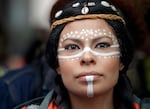Every U.S. city with some kind of tribal affairs office has a slightly different structure.
In Albuquerque, the city’s Native American Affairs office does both Native community engagement and tribal government relations. In Denver, the American Indian Commission focuses strictly on the needs of the city’s Native residents. And in Seattle, the city has an office focused on government tribal affairs and community engagement programs embedded in different city departments.

Dr. Leslie Jimenez, Hopi Nation member and descendent of Mexican and Ethiopian indigenous peoples, wears traditional celebratory face paint as she attends an Indigenous Peoples Day blessing and rally in Seattle in 2018.
Elaine Thompson / AP
Tim Lehman, a citizen of Northern Arapaho, has been Seattle’s Indigenous Planning Strategist in the city’s planning department since the position was created two years ago. His job, he said, is to “decolonize what planning looks like” in city government, by bringing local Indigenous perspectives into policy conversations.
He said his work wouldn’t make sense to couple with the city’s tribal government program, since many Native Seattleites aren’t citizens of tribes that the government works with.
“There’s some overlap, but it’s also a distinctly different population,” said Lehman.
Portland is using Seattle’s structure as a model for its new program. There is one significant difference: Seattle has an Indigenous Advisory Council, which gives city government input on issues affecting Indigenous people in Seattle. Creating a similar body is one of PILR’s top recommendations.
Sam Chase, with the city’s Office of Government Relations, said the city won’t consider adding something like this until it gets more public feedback on whether it’s necessary.